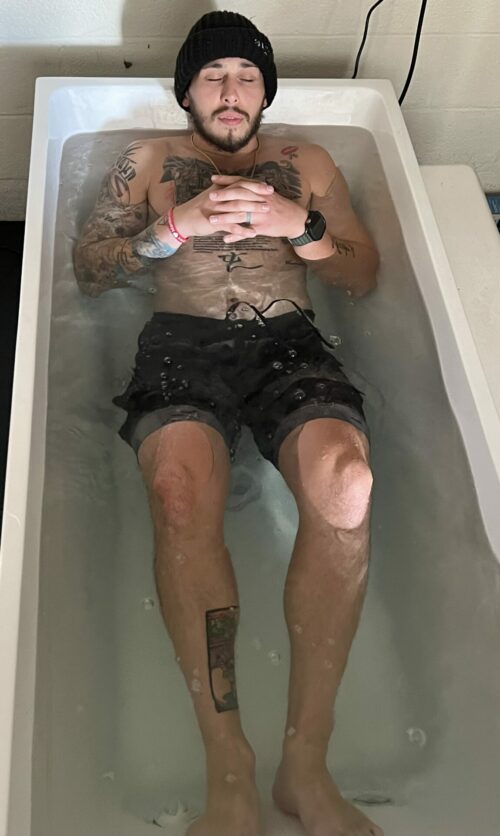Our very own Greenwich trainer, Che, pictured here utilizing the healing power of cold therapy in a full body ice bath!
Ever wonder why many athletes take a cold shower or sit in a tub of icy cold water after a big game?
It’s because cold water has many health benefits that can improve a variety of conditions and help your body feel better especially after a workout.
Below, we’ll take a closer look at cold therapy, some of its many benefits and offer some helpful tips to prevent any issues or injuries when incorporating this wellness tool into your lifestyle.
What is Cold Therapy?
Cold therapy, also known as cryotherapy, might sound like something out of a sci-fi movie, but it’s actually a simple yet effective way to boost your health.
At its core, cold therapy involves exposing your body to cold temperatures for various durations using various methods such as cold showers, full body ice baths, or a plunge into a cold lake or ocean. The idea is to stimulate a range of physiological responses that can help relieve and improve a variety of issues including post-workout muscle soreness, everyday aches and pains, and even depression and anxiety.
The key is to stay in the water long enough to acclimate and slowly build up your body’s response with a big focus on your breath. Taking long, deep breaths and relaxing the body before you enter the water and while you are exposed to the water signal to your body that you are in a rested state and that what is happening is ok. You want to avoid taking quick, shallow breaths as we often are inclined to do in cold temperatures. This will send the body into a panic and will not give you the healing and calming effects that cold therapy can provide.
What are the Benefits of Cold Therapy?
In recent years, cold therapy has gained increased interest due to its contribution to numerous health benefits, including:
Reduces Inflammation and Soreness
If you’ve ever experienced post-workout muscle soreness, you know how uncomfortable it can be. Cold therapy can help reduce inflammation and muscle soreness by constricting blood vessels. This reduces blood flow to the sore areas which then helps reduce swelling and inflammation.
For years, most college-level and professional sports teams have implemented cold therapy into their programs to improve players’ muscle soreness or injuries such as ankle sprains after games and practice sessions. The use of cold therapy also helps athletes recover in time for upcoming games.
Decreasing inflammation throughout the body can also help alleviate chronic ailments such as autoimmune disorders, depression, and anxiety as well as more acute issues such as arthritis and joint pain.
Stimulates the Vagus Nerve and Regulates the Nervous System
The Vagus Nerve is the longest nerve in our autonomic nervous system. It controls all of our major organs and digestive system and it holds some of the keys to improved health.
One of the key functions of the Vagus Nerve is to trigger the opposite response to fight, flight and freeze. Therefore, it is able to move our body into a more regulated and meditative state, free from stress and ready to relax.
Stimulating the Vagus Nerve is a significant step towards getting out of a constant fight or flight state by quieting your mind and increasing your ability to focus, rest, and digest food.
Supports a Strong Immune System
Exposing your body to cold temperatures can help stimulate your immune system. This, in turn, may help your body become more resilient to illnesses. In fact, a study that was conducted within the last ten years which tested a variety of techniques, showed positive immune responses from those who participated in cold water immersion therapies.
Helps Individuals Recover from Surgery
Cold therapy is also seeing an increase in usage in post-surgical rehabilitation initiatives. Since this therapy can help alleviate pain by reducing swelling and inflammation, more medical experts are recommending cold therapy for their patients, especially those who have experienced soft tissue trauma. By incorporating this therapy into their rehabilitation program, patients may enjoy increased functionality at a much higher rate.
Improves Breathing and Circulation
As cold temperatures cause blood vessels to constrict and then dilate upon being exposed to warmer conditions, incorporating brief durations of cold therapy can help improve your overall circulation by focusing on your breath. Slow, deep breathing can improve blood oxygenation and circulation which helps support more efficient nutrient and oxygen transport throughout your body.
Reduces Stress, Improves Mood and Contributes to Quality Sleep
Cold therapy can have a positive impact on mood and mental well-being. Exposure to cold temperatures triggers a stress response in the body that leads to the release of hormones like adrenaline and cortisol that help us deal with stressful situations by increasing blood sugar levels and boosting energy production.
Cold therapy has also been shown to stimulate the release of endorphins, the body’s natural mood elevators. This can help improve your mood by helping you feel less anxious and more relaxed, similar to the “runner’s high” experienced after intense exercise.
Additionally, cold therapy may improve sleep quality by regulating the body’s circadian rhythms. It can help reset the sleep-wake cycle, leading to more restful and refreshing sleep, which in turn also contributes to a better mood and more energy during the day.
Helps with Weight Management
Cold therapy, such as ice baths or cold exposure, can contribute to weight management through several mechanisms, such as burning calories and fat.
When your body is exposed to cold temperatures, it works harder to maintain its core temperature. This process, known as thermogenesis, burns additional calories. Regular exposure to cold may help boost your overall calorie expenditure, potentially supporting weight loss.
Cold exposure may stimulate your body to burn more fat for energy. This can be especially beneficial for individuals looking to reduce body fat percentage. It activates brown adipose tissue, which is involved in fat metabolism.
Safety Tips for Cold Therapy
While cold therapy has numerous benefits, it’s essential to practice it safely. To do so, it’s important to take the following steps to help prevent any potential health issues or injuries:
- Consult a medical professional before beginning any cold therapy regimen, especially if you have underlying health conditions.
- Always start with shorter exposure times and gradually increase them as your body adapts
- Be careful not to overdo it. Avoid getting to the point where you start to shiver, exit just before this happens.
- Avoid shallow breathing. Focus on taking long, deep breaths in thru your nose and out thru your mouth to keep your body and nervous system calm.
Is Cold Therapy Right For You?
Are you intrigued by the potential health and post-workout benefits of cold therapy? Do you have questions or concerns about incorporating it into your wellness routine?
Loyalty Fitness is here to help.
Contact our team today for expert guidance on how to safely and effectively integrate cold therapy into your quest for better healing.
CHALLENGE
At the end of your next shower, turn the temperature to as cold as you can handle for 30 seconds. Focus on your breath- inhaling thru your nose and exhaling thru your mouth, slow and steady. Switch back to hot water for 30 sec. And then back again to cold for another 30 sec. Each time you shower, try to slowly increase the time of cold exposure by 5-10 sec.

